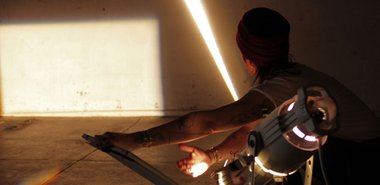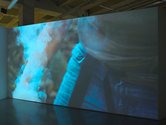John Hurrell – 19 May, 2017
The title comes from Monique Wittig's famous novel, Les Guérillères (1969), a series of prose poems where lesbian women have taken over the world after defeating men in a bloody war. It is a clever choice of language because women as active participants dominate the film, and sunlight is a conspicuous feature in the production's imagery.
I can’t remember the last time I saw Puerto Rican art in Auckland. It was probably the work of Jennifer Allora and Guillermo Calzadilla in Auckland Art Gallery during the 2013 5th Auckland Triennial - (Remember those? Weren’t we going to have the 6th one last year?) - examining the same Caribbean island (Vieques) with its history of US Naval presence and contaminated jungles (due to bombing practice) that Beatriz Santiago Muñoz sometimes focuses on in this visually delicate, most interesting show.
The title comes from Monique Wittig‘s famous novel, Les Guérillères (1969), a series of prose poems where lesbian women have taken over the world after defeating men in a bloody war. It is a clever choice of language because women as active participants dominate the film, and sunlight is a conspicuous feature in the production’s imagery.
In Gallery One Muñoz presents two looped film works (each approximately 10 minutes) where the large space is divided diagonally by a long wall. On one side is a single channel projection, Post-Military Cinema (2014), and on the other, a suite of obliquely angled (spread apart) separate screens for a three channel work, That which identifies them, like the eye of the Cyclops (2016). The former looks at an abandoned picture theatre in Ceiba that was part of the Roosevelt Roads Naval base, that has been invaded by bees and surrounded by jungle; the latter the activities of a group of close women friends who are goat and sheep farmers, along with a teacher, a singer (we hear her singing some fifties rockabilly in a danceclub) and a union organiser. The voice-over, aurally centred on the middle screen, sporadically darts around in its references to the activities on all three.
The themes in the three screen work revolve around camarade, the love and care of animals (Muñoz’s images have a lot in common with Dianne Thater’s), the ambiguous properties of language, the poisoning of the earth, and the use of reflected coloured light as a semaphore system during the gender-based war of Wittig’s book. Light, whether reflected via mirrors or rippling estuary water, or seen through coloured translucent Perspex sheets, is a conspicuously pervading theme, and this continues in Post-Military Cinema, where afternoon light penetrates the building through a small hole in the door fifty minutes a day. The camera relishes the dappled patterns on the furniture, the shimmering dancing reflections mingled with continually refocusing lacelike shadows.
I’m the sort of person that is easily mesmerised by afternoon sunlight coming through cracks in my bedroom blind and causing moving dappled patterns on the opposite wall. Such distraction is dopey for sure - I glaze over like the proverbial ‘stunned mullet’ - but I’m nevertheless engrossed, while also being aware that it will last three or four minutes at max. I suspect Muñoz too is fascinated by such transience, whether that be represented by autumnal sunlight, equatorial vegetation growth, moving water, the life cycle of social insects, or the gestation, evolution and eventual collapse of communities.
An understated, but lovely, richly informative, exhibition.
John Hurrell




 Two Rooms presents a program of residencies and projects
Two Rooms presents a program of residencies and projects Advertising in this column
Advertising in this column



This Discussion has 0 comments.
Comment
Participate
Register to Participate.
Sign in
Sign in to an existing account.